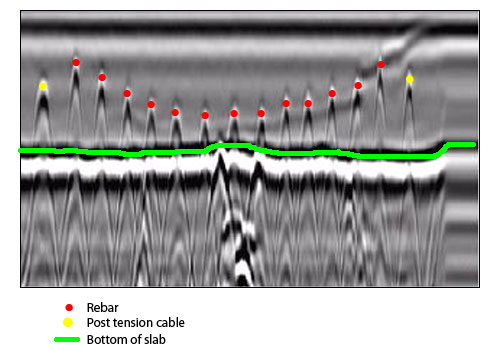Choosing the Right Concrete Scanning Tools
Choosing the Right Concrete Scanning Tools
Blog Article
Elevate Your Building And Construction Process With the Strategic Insights of Concrete Scanning for Boosted Productivity
In the world of contemporary building and construction practices, the mission for efficiency and accuracy is critical. Embracing cutting-edge modern technologies has actually come to be a foundation for attaining these goals. One such technology that has reinvented the building and construction market is concrete scanning. By taking advantage of the tactical understandings given by concrete scanning, building and construction experts can unlock a world of enhanced productivity and streamlined processes. The ramifications of incorporating concrete scanning go much past surface-level advantages, using an extensive influence on task outcomes.

Advantages of Concrete Scanning
Enhancing job efficiency and safety, concrete scanning uses a non-destructive method for identifying hidden things within concrete frameworks. By utilizing technologies such as ground-penetrating radar (GPR) and concrete x-ray imaging, building groups can properly situate rebar, post-tension cables, electrical channels, and other obstructions before exploration, reducing, or coring into concrete.
The benefits of concrete scanning are countless. Building websites can be complex atmospheres, and understanding what exists underneath the surface area can avoid injuries and accidents.
Additionally, concrete scanning promotes overall task efficiency by simplifying workflows and preventing rework. By identifying potential problems early on, teams can adjust their strategies proactively, saving time and resources in the future. Basically, the adoption of concrete scanning technologies is a calculated investment that pays returns in terms of safety and security, efficiency, and cost-effectiveness.
Innovation Assimilation for Efficiency
Concrete scanning's ability to streamline operations and improve task performance can be additional enhanced through calculated assimilation of sophisticated technologies. By incorporating Building Info Modeling (BIM) software application right into concrete scanning procedures, building groups can accomplish a greater level of accuracy and coordination. BIM permits the development of 3D designs that offer thorough insights right into the task, making it possible for better decision-making and decreasing the probability of errors. Furthermore, the combination of Augmented Reality (AR) technology with concrete scanning can improve on-site visualization, permitting task supervisors and employees to overlay electronic info onto the physical setting in real time. This can assist in much more exact positioning of elements and improve communication amongst employee. The use of drones for airborne studies in combination with concrete scanning can speed up data collection and evaluation, allowing much faster decision-making and development tracking. On the whole, the calculated assimilation of these modern technologies can dramatically boost performance and performance in construction projects.
Avoiding Pricey Errors
How can careful focus to information during concrete scanning procedures assist building teams in avoiding costly mistakes? By making use of innovative scanning modern technologies such as Ground Penetrating Radar (GPR) and electromagnetic induction, construction groups can precisely identify rebar, energies, voids, and various other blockages within concrete frameworks. Additionally, concrete scanning assists in guaranteeing architectural stability by identifying weak points or flaws in the concrete early on, allowing for timely repair work and adjustments.
Enhancing Project Administration
Thorough focus to detail during have a peek at this website concrete scanning refines not only helps in staying clear of pricey errors yet additionally lays a strong structure for efficient project administration in building and construction undertakings. By integrating concrete scanning innovation right into task administration techniques, building and construction teams can streamline process, boost interaction, and make sure that jobs remain on track.
Concrete scanning offers important insights into the structural stability of existing elements, enabling task supervisors to make enlightened choices relating to style alterations or building and construction series. This positive technique lessens the risk of unexpected delays or revamp, inevitably conserving time and sources. Additionally, the data obtained from concrete scanning can be integrated right into Structure Info Modeling (BIM) platforms, making it possible for real-time partnership and coordination among different stakeholders.
Moreover, concrete scanning aids task managers determine prospective dangers or challenges prior to they rise into larger concerns, advertising a much safer job environment for all entailed. With boosted visibility and precision provided by concrete scanning innovation, project managers websites can efficiently plan, monitor, and implement construction projects with greater performance and self-confidence.
Making Best Use Of Productivity
One essential element of optimizing performance is via the fostering of concrete scanning modern technology. By making use of ground-penetrating radar (GPR) and other scanning methods, building and construction groups can precisely find rebar, channels, and various other subsurface elements, minimizing the danger of pricey errors and delays during excavation and exploration.
Furthermore, accepting Structure Information Modeling (BIM) software program can significantly enhance productivity by creating thorough 3D models that improve project visualization and sychronisation among various trades. BIM permits far better clash discovery, enabling issues to be identified and settled before construction even starts, conserving time and resources in the future.
Executing a lean building technique, which concentrates on getting rid of waste and optimizing efficiency across all task phases, is another important site reliable technique for taking full advantage of performance. By cultivating partnership, interaction, and constant improvement, building groups can work a lot more cohesively in the direction of attaining project goals in a streamlined and productive fashion.
Final Thought
Finally, the calculated application of concrete scanning in the construction procedure offers various advantages, including raised performance, price savings, improved project administration, and boosted efficiency. By integrating this technology, construction teams can stay clear of expensive mistakes, enhance their operations, and maximize their overall task result. Concrete scanning is a beneficial tool that can elevate the building and construction process and cause even more effective and successful results.

Report this page